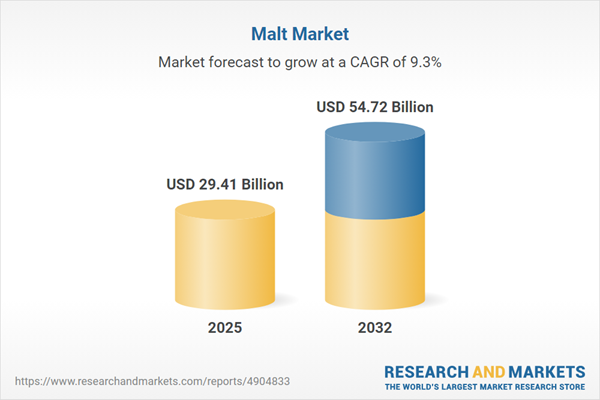Speak directly to the analyst to clarify any post sales queries you may have.
The malt market is undergoing significant transformation as companies pursue digital innovation, compliance, and transparency to maintain a competitive edge. Senior decision-makers are confronted with evolving technologies, dynamic consumer expectations, and supply chain complexity, making actionable insights critical for informed strategy.
Malt Market Snapshot: Growth and Emerging Trends
The global malt market is projected to expand steadily from 2024 to 2032, driven by robust demand in both traditional applications like brewing and emerging fields such as advanced food processing. Brands are leveraging specialty malt to carve out niche differentiation and respond to increasingly diverse market needs. Accelerated digitization is reshaping business models, with organizations adopting real-time process monitoring and advanced analytics to enhance operational flexibility. Greater visibility across supply chains supports rapid adaptation to regulatory change and shifting customer expectations, while innovative processing methods enable companies to capitalize on evolving commercial opportunities. As competition intensifies, organizations are optimizing their processes to address complex requirements and reinforce market standing.
Malt Market Scope & Segmentation
This report delivers executive-level intelligence, illustrating how strategic segmentation enhances planning and resource deployment across the malt industry. Segment analysis is fundamental to identifying emerging opportunities, mitigating risk, and sharpening competitive differentiation in diverse markets.
- Malt Type: Amber, Crystal, Dark, Pale, and Specialty malts offer unique color and flavor characteristics. This diversity allows organizations to tailor product development for brewing, food, and nutraceutical use, responding directly to distinct consumer and industry demands.
- Form: Both Liquid and Powder malts provide operational advantages, supporting flexible stock management, streamlined sourcing, and diverse distribution strategies within complex supply chains.
- Extraction Method: Enzymatic and Mechanical approaches are crucial for efficient large-batch malt processing and compliance with environmental regulations and industrial standards.
- Application: The market supports Brewing, Distilling, and a wide spectrum of Food and Beverage manufacturing—including bakery, confectionery, and snacks—as well as increasing activity in Pharmaceuticals, extending relevance across established and emerging sectors.
- Region: Analysis covers the Americas, Europe, Middle East & Africa, and Asia-Pacific, noting that regional strategies must align with distinct preferences, compliance norms, and infrastructure realities.
- Key Players: Boortmalt NV, Malteurop GmbH, Soufflet Malt SAS, Cargill Incorporated, Viking Malt OÜ, Simpsons Malt Limited, Rahr Malting Group LLC, Great Western Malting Company, Muntons PLC, and Crisp Malting Group Limited are the main drivers of innovation and standards across the industry.
Malt Market: Key Takeaways for Decision-Makers
- Specialty malts are becoming central for product differentiation, enabling producers to meet shifting consumer preferences and align with trends in health-focused ingredients.
- Automated production systems and advanced analytics provide agility, support regulatory compliance, and facilitate rapid process adaptations in response to market or policy changes.
- Full supply chain transparency fosters trust throughout partnerships and helps companies achieve comprehensive traceability across sourcing, processing, and delivery stages.
- Strategic sourcing and adaptive supplier management allow organizations to better navigate pricing fluctuations and supply chain disruptions, strengthening resilience in the face of uncertainty.
- Diversification into non-alcoholic and nutrition-driven product lines is opening access to new consumer segments, enhancing revenue streams in a competitive global landscape.
- Ongoing investment in research and digital technologies expands innovation capacities and keeps organizations in step with fast-changing expectations from stakeholders and industry benchmarks.
Tariff Impact in the United States
Recent tariffs on malt imports in the United States are sharpening executive focus on sourcing and logistics. Companies are reassessing risk and intensifying supply chain planning to safeguard operational flexibility and adapt to evolving trade regulations.
Methodology & Data Sources
This analysis is built on executive interviews across malting, beverage, and agribusiness sectors, supported by procurement surveys, sustainability evaluations, regulatory reviews, and supply network analyses to deliver comprehensive insights for leadership.
Why This Report Matters
- Equips senior leaders to anticipate sector changes through actionable trends and regulatory foresight, streamlining strategic planning and technological integration.
- Delivers clear regional and segment-specific insights for optimal allocation of resources and effective market-entry strategies.
- Provides deep intelligence on supply chain operations, risk mitigation, and strategic partnership opportunities in a changing marketplace.
Conclusion
This report serves as a practical resource for executives, offering the clarity required to refine growth strategies, reinforce resilience, and confidently guide organizations through industry evolution.
Additional Product Information:
- Purchase of this report includes 1 year online access with quarterly updates.
- This report can be updated on request. Please contact our Customer Experience team using the Ask a Question widget on our website.
Table of Contents
3. Executive Summary
4. Market Overview
7. Cumulative Impact of Artificial Intelligence 2025
Companies Mentioned
The companies profiled in this Malt market report include:- Boortmalt NV
- Malteurop GmbH
- Soufflet Malt SAS
- Cargill, Incorporated
- Viking Malt OÜ
- Simpsons Malt Limited
- Rahr Malting Group LLC
- Great Western Malting Company
- Muntons PLC
- Crisp Malting Group Limited
Table Information
| Report Attribute | Details |
|---|---|
| No. of Pages | 188 |
| Published | November 2025 |
| Forecast Period | 2025 - 2032 |
| Estimated Market Value ( USD | $ 29.41 Billion |
| Forecasted Market Value ( USD | $ 54.72 Billion |
| Compound Annual Growth Rate | 9.2% |
| Regions Covered | Global |
| No. of Companies Mentioned | 11 |









